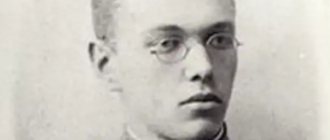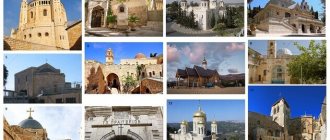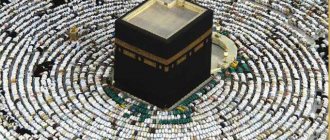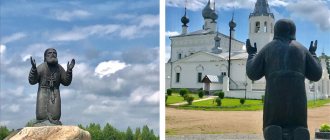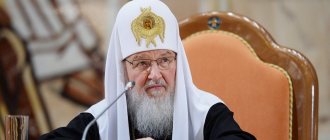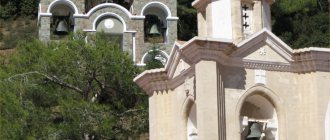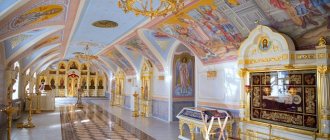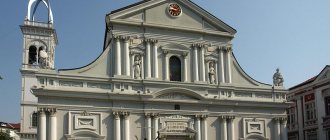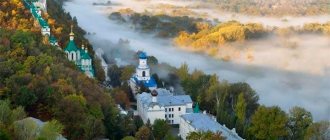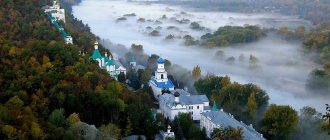The Vologda Metropolis is a fairly ancient metropolis of the Russian Orthodox Church. It consists of three dioceses: Vologda and Kirillov, Cherepovets and Belozersk, Veliky Ustyug and Totem dioceses.
Trinity Church in the city of Totma, Vologda region, belongs to the Vologda Metropolis
Story
Before the establishment of the Vologda diocese, its northwestern region was part of the Novgorod diocese, and the southern and eastern regions were part of the Rostov diocese[1].
In 1492, Archbishop Gennady of Novgorod ceded Vologda to the Perm diocese. By decree of the cathedral in 1589, the department was moved to Vologda and the bishops began to be called Vologda and Velikoperm[1].
In the last decades of the 18th century, the boundaries of the dioceses were brought into line with the boundaries of the provinces. A number of territories of the Vologda diocese, which ended up in the Kostroma, Tver, Novgorod, and Arkhangelsk provinces, were transferred to the corresponding dioceses.
In 1918, classes at the Vologda Theological Seminary, theological school and the diocesan women's school ceased. In 1918-1919, all house churches in Vologda (with the exception of the cross church at the bishop's house) and city monasteries were closed; in most monastery churches, which became parish churches, services were performed until the end of the 20s.
In 1921-1922, the Vologda clergy actively participated in raising funds for the benefit of the starving people in the Volga region. In 1921, gatherings were held in churches, and in February 1922, two spiritual concerts were held in favor of the starving. However, this did not prevent the authorities from carrying out a massive confiscation of church valuables in the province. From the churches of the Vologda province, 4 pounds 42 spools of gold, 393 pounds 20 pounds of silver, 5 pounds 86 spools of silver with pearls, 5003 precious stones, 4 pounds 21 spools of pearls, 29 pounds 10 spools of pearls in sewing were seized.
On December 16, 1929, the Presidium of the All-Russian Central Executive Committee adopted a resolution “On the regulation of bell ringing in churches,” which actually prohibited it. In Vologda, on December 29, 1929, at a meeting of the Presidium of the Vologda City Council, a resolution was adopted to prohibit the ringing of bells in all churches of the city, and a proposal was also developed to the All-Russian Central Executive Committee with a request to allow the removal of bells from city churches and their transfer to the non-ferrous metallurgy fund.
In 1929-1930 there was an impressive wave of church closures.
In 1937, the Vologda region was formed - from 1939/1940 until the fall of 1942, services on its territory were performed in a single church - the lower church of the Bogorodskoe cemetery of Vologda. In 1944, the diocesan boundaries were brought into line with the regional ones. By 1948, 17 churches operated on the territory of the diocese.
On October 23, 2014, by the decision of the Holy Synod, two new ones were separated from the Vologda diocese: the Cherepovets and Belozersk diocese and the Veliky Ustyug and Totem diocese[2].
The Vologda diocese includes 10 deaneries, there are 2 cathedrals
The Vologda diocese includes such districts as Vozhegodsky, Verkhovazhsky, Kirillovsky, Gryazovets, Sokolsky, Kharovsky and others.
The diocese also includes 10 deaneries, which include 105 churches in the region. There are only 2 cathedral churches in the diocese.
Saint Sophia Cathedral
In other words, the Cathedral of Sophia of the Wisdom of God is one of the oldest stone structures on the territory of Vologda. It is also considered one of the largest buildings of the era of Ivan the Terrible. Built in 1568 - 1570 by order of Ivan the Terrible himself. Since 1587, the temple has been considered a cathedral in the Vologda diocese. The cathedral preserves frescoes from the 17th century and an iconostasis from the first half of the 18th century.
St. Sophia Cathedral of the Vologda diocese is one of the largest buildings of the era of Ivan the Terrible
Resurrection Cathedral
Another cathedral in the city of Vologda. It was built in 1772 as a warm temple. Construction took place by order of Archbishop Joseph the Golden. Currently, the cathedral is an architecture of feudal significance.
Resurrection Cathedral of the Vologda diocese - currently architecture of feudal significance
Bishops
- Joasaph I (1558-1570)
- Macarius (1568-1574)
- Varlaam I (1576—1584)
- St. Anthony (October 11, 1585 - October 26, 1587)
- Jonah (Dumin) (June 1588—1603)
- Joasaph II (December 1603 - mentioned May 1609)
- Sylvester (July 1611 - July 11, 1613)
- Nectarius the Greek (June 25, 1613-1616)
- Macarius (February 9, 1617 - July 22, 1619)
- Cornelius (February 6, 1620 - March 17, 1625)
- Nectarius the Greek (May 1625 - June 3, 1626)
- Varlaam II (October 8, 1626 - January 1645)
- St. Marcellus (16 January 1645 – 22 March 1663)
- Simon (23 October 1664 - August 1684)
- Gabriel (Kichigin) (September 7, 1684 - March 30, 1707)
- Joseph (October 17, 1708 - January 18, 1716)
- Pavel (Vasiliev) (January 29, 1716 - November 5, 1725)
- Joachim (March 16 - April 22, 1726)
- Athanasius (Paussius-Kondoidi) (October 9, 1726 - September 17, 1735)
- Ambrose (Yushkevich) (February 2, 1736 - May 29, 1740)
- Pimen (Savelov) (June 29, 1740 - May 26, 1753)
- Serapion (Lyatoshevich) (October 29, 1753 - December 1761)
- Joseph (Zolotov) (December 16, 1761 - December 25, 1774)
- Iriney (Bratanovsky) (April 26, 1775 - April 23, 1796)
- Arseny (Todorsky) (August 15, 1796 - June 15, 1802)
- Anthony (Znamensky) (July 5, 1802 - February 13, 1803)
- Theophylact (Slonetsky) (April 26, 1803 - January 3, 1808)
- Evgeny (Bolkhovitinov) (January 24, 1808 - July 19, 1813)
- Onisifor (Borovik) (February 22, 1814 - November 28, 1827)
- Moses (Bogdanov-Platonov-Antipov) (November 28, 1827 - November 29, 1828)
- Stefan (Romanovsky) (November 24, 1828 - March 1, 1841)
- St. Innocent (Borisov) (March 1 - December 31, 1841)
- Irinarh (Popov) (January 12, 1842 - November 12, 1844)
- Evlampy (Pyatnitsky) (November 22, 1844 - June 15, 1852)
- Feognost (Lebedev) (July 13, 1852 - July 31, 1856)
- Christopher (Emmaus) (July 31, 1856 - June 17, 1866)
- Pavel (Dobrokhotov) (August 21, 1866 - July 7, 1869)
- Palladium (Raev-Pisarev) (July 15, 1869 - June 13, 1873)
- Feodosius (Shapovalenko) (June 13, 1873 - August 22, 1883)
- Israel (Nikulitsky) (October 25, 1883 - April 23, 1894)
- Anthony (Florensov) (April 30, 1894 - June 12, 1895)
- Alexy (Sobolev) (June 12, 1895 - April 21, 1906)
- Nikon (Rozhdestvensky) (April 25, 1906 - May 29, 1912)
- Anthony (Bystrov) (1911) v/u, ep. Velsky
- St. Alexander (Trapitsyn) (May 16, 1912 - March 1921)
- Alexander (Nadezhdin) (March 1921 - November 1922) deviated from Renovationism
- Pavel (Vilkovsky) (August 26 - October 1923) was not at the department
- Pavel (Kratirov) (September 4 - October 22, 1923) v/u
- Sylvester (Bratanovsky) (October 22, 1923-1928) Nikolai (Karaulov) (1925) v/u, bishop. Velsky
- 1940-1944 - the diocese was widowed
Church of Elijah the Prophet in Kamenye
Church of Elijah the Prophet in Kamenye - Orthodox church, inactive, address: st. Zasodimsky, 14B.
The Church of Elijah the Prophet is a small white cubic stone temple, made in a very attractive and harmonious design due to its simplicity. The decoration of the church is only a relief cornice and one dome of a classical form.
The church was built in 1698 and has survived to this day. But the date of construction of the previous wooden church is unknown, because the chronicle of the Elias Monastery (which included the Church of Elijah the Prophet) began only with the arrival of Ivan the Terrible (mid-16th century). In 1738, the Ilyinsky Monastery was abolished, and the church became a parish.
The postscript “in Kamenye” probably appeared due to the storage in these places of reserves of stones for the construction of the Vologda Kremlin. There is also an assumption that previously there was a stone pagan idol at this place.
Monasteries
- Spaso-Prilutsky Dimitriev Monastery (male; Vologda)
- Kirillo-Belozersky Monastery (male; Kirillov)
- Goritsky Resurrection Monastery (women; Goritsy village, Kirillovsky district)
- Holy Trinity Pavlo-Obnorsky Monastery (male; Gryazovets district)
- Spaso-Kamenny Monastery (male, Ustyanskoye rural settlement, Ust-Kubinsky district)
- Ferapontov Belozersky Monastery (male; Ferapontovo village)
- Zaonikievskaya Bogoroditsa-Vladimirskaya Hermitage (female; Luchnikovo village, Vologda district)
- Gorne-Uspensky Monastery (women; Vologda)
- Nilo-Sorskaya Pustyn (male; Pustyn town, Kirillovsky district)
- Rabang Spaso-Preobrazhensky Monastery (male; Sloboda village, Sokolsky district)[3]
inactive
- Korniliev-Komelsky Monastery (male)
- Aleksandro-Korovinskaya hermitage (Gryazovets district)
The Cherepovets diocese contains 13 deaneries, 83 churches and 2 monasteries
Now let's look at the other 2 dioceses that are part of the Vologda Metropolis. The Cherepovets diocese includes such districts as Babaevsky, Kaduysky, Ustyuzhensky, Belozersky, Chagodoshchensky, Vashkinsky and others.
The ruling bishop is Bishop Flavian, who has the title of Cherepovets and Belozersk. The diocese includes 13 deaneries, in which there are 83 churches and 2 monasteries. There are two cathedrals in the Cherepovets diocese.
The ruling bishop is Bishop Flavian, has the title of Cherepovets and Belozersk
Cathedral in the name of Saints Athanasius and Theodosius of Cherepovets
The upper altar of the temple is consecrated in honor of the Feast of the Annunciation of the Most Holy Theotokos, and the lower altar is in honor of Saints Athanasius and Theodosius and the Cherepovets.
Cathedral in the name of Saints Athanasius and Theodosius of Cherepovets, belongs to the Cherepovets diocese
In the lower church, on the ground floor, there is a baptismal font. The funeral service and memorial service are also held in this place. The top one is larger than the bottom one, it looks more solemn. It hosts morning and evening liturgies and prayer services.
Transfiguration Cathedral
The time of construction dates back to 1668. It is a four-pillar temple with five onion domes. The cathedral has preserved a multi-tiered iconostasis from the late 18th century.
Spaso-Preobrazhensky Cathedral of the Cherepovets diocese - date of construction dates back to 1668, currently belongs to the city museum
Divine services were held there until August 1937. During the terror, all the priests were arrested and shot in Leningrad. After the closure of the temple, its interior was maintained in proper condition. Currently the temple belongs to the city museum.
Church of St. John Chrysostom
Church in the name of St. John Chrysostom - an Orthodox church, active, address: VI Army Embankment, 105.
The Church of St. John Chrysostom, also called the Myrrh-Bearing Women, was built in the period 1650-1700. and is one of the oldest stone churches in Vologda. It, like many other churches in Vologda, is divided into cold and warm parts.
The cubic temple is crowned with five domes, the zakomars are separated by a cornice line, and the windows are decorated with various platbands. The tent-type bell tower is installed on a disproportionately massive quadrangle. Due to the fact that during Soviet times the church was used as a warehouse, it was possible to preserve not only the historical building itself, but also fragments of wall paintings and stucco moldings.
Church of the Assumption of the Blessed Virgin Mary on Navolok
Church of the Assumption of the Blessed Virgin Mary on Navolok - an Orthodox church, active, address: VI Army Embankment, 119.
The Church of the Assumption of the Blessed Virgin Mary was built as a warm church next to the cold one of Demetrius of Prilutsky, forming one Dmitrievsky parish. Date of construction: 1750.
The Winter Assumption Church is very small in size and very elongated in length, which is very typical for warm churches of the North. A baroque bell tower was added to the western side. Its vertical composition is represented by a quadrangle serving as a porch, two octagons placed on top of each other, and a dome. A massive portal is installed at the entrance to the church.
Church of the Intercession of the Virgin Mary at Torg
Church of the Intercession of the Virgin Mary on Torg is an active Orthodox church, address: Torgovaya Ploshchad, 8.
The Church of the Intercession on Torg was built in 1778 - 1780. on the site of the more ancient wooden church of Joachim and Anna, which was located inside the territory of the Vologda Kremlin and was the home church of Tsar Ivan the Terrible. The toponym “at Torgu” came into use in connection with the large trading area located nearby, which was the center of trade in the city.
The Church of the Intercession is made in the traditions of ancient Russian architecture: a simple cubic shape with one dome, a low refectory with two domes and a low hipped bell tower. In the second half of the 19th century. the church was decorated with a massive porch in pseudo-Russian style. Although the church was closed during Soviet times, it has survived to this day without any significant damage or reconstruction.
Church of Zosima and Savvaty Solovetsky
Church of Zosima and Savvaty Solovetsky - Orthodox church, inactive, address: Prechistenskaya embankment, 21.
The Church of Zosima and Savvaty Solovetsky was built between 1759 and 1773. The church looked very elegant and enjoyed great patronage from the provincial authorities. It was built in the spirit of early Moscow Baroque: a multi-level bell tower with a high spire, elegant platbands and a red and white color scheme. Later, a two-story porch in neo-Russian style was added to the church.
Since 1930, the church has changed greatly in appearance: the dome and bell tower were dismantled, the porch was stripped of its neo-Russian decor, and the quarters were rebuilt into an octagon. And now it seems that not a trace remains of the former building. Nowadays the Teremok Puppet Theater is located in the Church of Zosima and Savvaty.
Church of St. Nicholas the Wonderworker on Glinki
Church of St. Nicholas on Glinki - an Orthodox church, active, address: st. Predtechenskaya, 74.
Until the beginning of the 17th century, the Church of St. Nicholas on Glinki was called Flora and Lavra in the Rassylschichy Sloboda. In the settlement there lived “messengers” - people engaged in the messenger (courier) business. The church stands exactly on the spot where the Zolotukha River, dug out on the orders of Ivan the Terrible, begins and served as a moat for the Vologda Kremlin. With the beginning of work on digging the river bed, clay was stored at this place, hence the name “on Glinka”.
The stone church was built in 1676, the bricks were made from extracted clay. The church was rebuilt many times: initially it was five-domed, and since 1770 it has been single-domed. The bell tower was also rebuilt: from a tented one to a spire-shaped one.
Al-Juma Grand Mosque
Al-Juma Cathedral Mosque is a functioning Muslim temple, address: st. Gorky, 5.
The Vologda Cathedral Mosque Al-Juma is considered the northernmost temple mosque in the European part of Russia.
They tried to collect money for the construction of a mosque in Vologda since 1910, when no more than a hundred Muslims lived in the city, however, the request was repeatedly refused due to the small number of believers. The large, spacious mosque was built only in 2001; before that, the Muslim community had to rent various premises.
